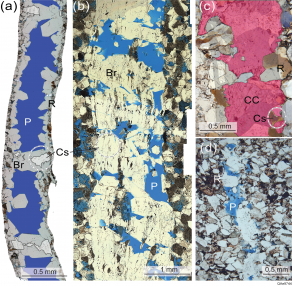
Quartz lined opening-mode fractures in Cretaceous sandstones, from various settings, Wyoming, a, b; and China, c, d. (a) Open fracture with bridges and rinds, intermediate depth (4.5 km) (modified from Laubach et al., 2016). Wyoming, Cretaceous Frontier Formation. Br, bridge; R, rind; Cs, crack-seal gap deposits (highlighted; dotted circle) marked by fluid inclusions and surrounded by lateral (post crack seal) quartz deposits (clear); P, Porosity. (b) Partly open fracture with thick rinds and wide quartz bridges, Br, (>6 km). Wyoming, Frontier Formation. P, porosity. Modified from Wang Q. et al., 2019. Core from a well that reached 7390 m in late 1980’s (Brown and Shannon, 1989). Similar quartz volumes, textures and fluid inclusion records to a and b are found elsewhere regionally, e.g., Fall et al., 2015; Hooker et al., 2015. (c) Cretaceous sandstone, Western China. Fracture, c. 6180 m, with narrow quartz rind, R, and overlap (later) calcite, cc. Cs, crack-seal texture marked by parallel fluid inclusion planes (dotted circle). Overlays highlight quartz in fracture (grey) and later calcite (red). (d) Fracture, c. 6880 m, with narrow quartz rind, R, and porosity, P. Images b, c from Junpeng Wang and Andras Fall. For similar deposits see Wang S. et al., 2023, Bashijiqike Formation, their figure 5g, i.
Ultra-deep basins | Our lead-off introductory paper to the special issue of the Journal of Structural Geology on brittle deformation in deep and ultra-deep basins was published in August 2023.
Many thanks to all the authors who worked with the editorial team through the review and revision process. And deep appreciation to the numerous reviewers who gave their time and expertise helping to make the special issue a reality.
The entire issue will be open access for the next six months.
This volume describes progress in understanding brittle structures in deep and ultra-deep (> 4 km to > 7 km) sedimentary basins. Under deep conditions in sandstone, carbonate rocks, shale, and other rocks, fluid charge and resource recovery are sensitive to faults and opening-mode fractures.
Deep and ultra-deep sedimentary basins occur worldwide, including in the U.S. and Canada, North Sea, Southeast Asia, Africa, Middle East, and China. Deep wells provide direct evidence of otherwise inaccessible crustal processes. Drillers reckon wells to be deep if they reach 4000 m and wells extending to 7000 m or deeper are ultra-deep.
Interest in deep and ultra-deep basins is growing due to the discovery and development of oil and gas reserves.
The geoscience literature on deep and ultra-deep basins is rapidly expanding. For example, in Google Scholar in 2023, of 450 papers that mention ultra-deep basins, more than two thirds appeared since 2015. Of thirty-nine papers that include ‘ultra-deep basin’ in title, about half are overviews or descriptions of seismic methods, engineering, fluid properties or modeling. The rest, more than half, are on fractures and faults (35%) and diagenesis (17%), reflecting a practical need to understand fluid flow, fluid storage, and rock strength at these depths.
In China, work is in progress on deep, deformed, and tectonically active basins including drilling of wells expected to exceed 10 km in depth.
Papers describing fractures in horizontal wells indicate locally highly clustered spatial arrangements. Orientation patterns record protracted superposed deformation.
Despite deep settings, open fractures are abundant, and wide (>1 mm) fractures with varying amounts of sealing calcite are common. Differences in cement abundances are due to the diagenetic history of fractures, not their origins (e.g., tectonic loading or elevated pore fluid pressure). In carbonate rocks, solution enhanced strike-slip faults and fractures with cavernous porosity are present, and in sandstone enigmatic enhanced host-rock porosity halos a few mm wide locally surround sealed fractures.
Owing to differences in thermal exposure due to recent (>6 Ma to present) rapid deep burial (in some cases >2000 m) and locally low geothermal gradients, some fractures at great depths are less diagenetically altered than those at shallower depths in the North American Cordillera. Contrasts in diagenesis may affect fracture size, spatial arrangement, and connectivity.
We introduce this special issue by putting basins of west and north China into a broader deep basin context, namely one that focuses on the age and timing of deep burial and thermal history. The underlying rationale for this is evident in the contributions that follow and when comparing brittle structures in China’s deep basins to observations from deep cores of the western North American Cordillera.
Papers in this volume underline the need for knowledge of linked structural and diagenetic processes to understand and successfully predict brittle structure at deep and ultra-deep basin levels. This is a perspective that usefully informs future work on such basins and points to thermal exposure rather than merely depth of burial as the appropriate context for structural analysis.
Laubach, S.E., Zeng, L., Hooker, J.N., Wang, Q., Zhang, R.H., Wang., J., Ren, B., 2023. Deep and ultra-deep basin brittle deformation with focus on China. Journal of Structural Geology 175, 104938 | view at publisher
© 2025 Jackson School of Geosciences, The University of Texas at Austin


